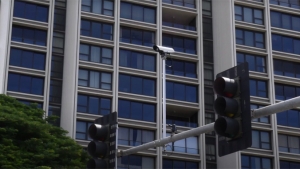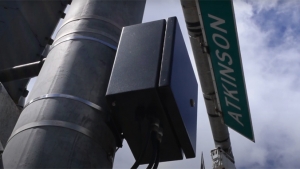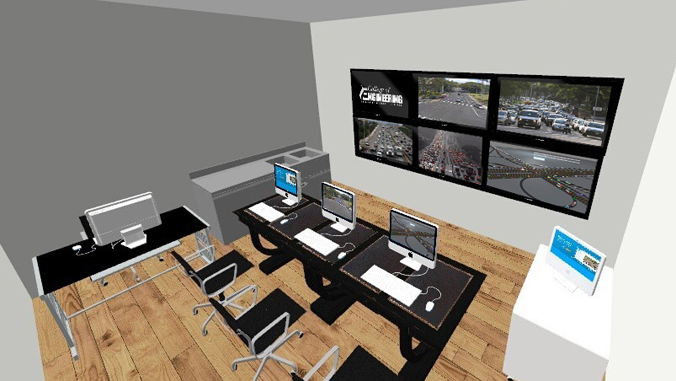In a first-in-the-nation project, the Hawaiʻi Department of Transportation is sponsoring a University of Hawaiʻi at Mānoa College of Engineering pilot project that is expected to greatly improve traffic flow through a critical Honolulu corridor, while giving students hands-on experience to prepare them for future careers.

This unprecedented initiative—through a partnership with the Hawaiʻi Department of Transportation (HDOT), Federal Highway Administration (FHWA), Econolite and Goldwings Supply—will utilize “Vehicle-to-Everything” communication technology, which connects vehicles, pedestrians and bicyclists, to the infrastructure. Signal devices have been installed at more than 30 intersections along Nimitz Highway and Ala Moana Boulevard.
Data collected by researchers will detail the operational improvements based on adaptive signal technology and will assist in increasing green time to a target of 60% via TravelSafely—available on the App Store and on Google Play. The app will provide Signal Phase and Timing and relative location alerts to all users of the highway.
Total funding for the deployment of this state-of-the-art system and research was $6 million, with 95 percent coming from HDOT.
Collaborative partnership
UH has partnered with Econolite to provide much of the system operations, maintenance and research.

David Ma, College of Engineering interim associate dean and professor, said UH students and faculty will spend four years analyzing the opportunities and challenges with the system so the state will be more prepared for future use of connected, autonomous vehicle (CAV) technologies; conducting research on sensor and data analytics to assist the system to operate to its full potential; and establishing a modern traffic engineering lab that will allow students to have first-hand experience of the most advanced traffic engineering technologies available and better prepare them for their future careers.
“In order to help the State of Hawaiʻi move forward with its visionary plan for future CAVs deployment, UH College of Engineering is proud to lead this effort of upgrading the traffic signal system of Nimitz Highway,” Ma said. “Not only will this project create a smart transportation corridor in the heart of downtown Honolulu, it also serves to show the state and UH’s commitment both to high-tech applications and to a safer, more efficient transportation system for Hawaiʻi.”
Econolite, a national leader in traffic management solutions, provided all hardware and software upgrades of the traffic signal system.
“Both UH and HDOT brought a get-it-done mentality,” said Econolite Vice President of Systems Integration Jon Ringler. “They helped break down traditional barriers and worked incredibly well with us to ensure work could continue despite COVID-19. There seemed to be no obstacle that they were not willing to partner on and help get the work done.”
Traffic engineering lab
Econolite also made a generous donation to UH to develop an advanced traffic engineering lab in Holmes Hall. The lab will be equipped with the most advanced traffic control, management and detection devices as well as a modern video wall for data visualization. Ma said the system will be a game changer for the College of Engineering.
“It will create unprecedented opportunities in cutting-edge research in traffic mobility and safety, such as vehicle-infrastructure integration, connected vehicle system control, arterial-wide speed harmonization and more,” Ma said. “The lab will become a mini traffic management center that enables UH researchers to analyze traffic data in real time and help HDOT staff make necessary adjustments to optimize the performance of the traffic system.”
Guohui Zhang, a civil engineering associate professor who teaches undergraduate and graduate courses in transportation engineering and a co-principal investigator of the research project commented, “This lab will significantly enhance our education program in transportation engineering. Students will be able to have hands-on experience with the state-of-the-art traffic technology and will be better trained as future traffic engineers.”
Ringler said, “Honolulu is a perfect location to expand the project and transform the entire city into a connected vehicle environment. Hawaiʻi is in a unique position to extend the current project and extrapolate a completely connected environment in a very similar fashion to the progress made by Singapore which is perhaps one of the most advanced countries/states in the world. As an insulated environment, there are a finite number of vehicles that can enter the state, a comparatively smaller population, but a dynamic urban and rural environment.”
—By Marc Arakaki


